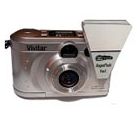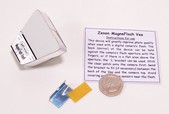The Magna Vee flash attachment. The problem with most compact digital cameras is that the flash is universally awful. Enter the Zenon Magna Vee flash unit. This small £8.00 ($15.00) attachment fits onto the front of your existing digicam flash and provides a colour corrected ‘soft flash’ which can considerably improve the photographs that you take. So does it work? Read on…
First impressions: The unit comes in a small package along with an angle bracket and sticky pad for attaching to your camera. In the event I found that this was far too cumbersome for everyday use (my pocket space being far too precious for any kind of angle, bracket or not) and so I simply rigged up a home made bracket. Made of Blu-Tack. It worked, albeit not very elegantly.
Peter Louden and the folk at Beckham Digital, the developers, are clearly photography geeks, because the unit is definitely somewhat spartan, no pretty designer frills here. The actual unit comprises a plastic ribbed fascia and a mirror arrangement which obviously both act to diffuse and filter the light coming from your vanilla flash unit. However, looks aside the Vee actually does work. Surprisingly well.
Results:
On the left, Hammy delivered with conventional camera flash light. On the right the Vee filtered version. It may not be obvious from the thumbnails (click on them for a larger sized image), but the Vee has taken away the harsh blue light we shudderingly associate with cheap digicams, replaced it with a warmer, more colour faithful alternative. Near sunlight they call it. It’s subtle but important for close up and portraits.
Another more striking example.
On the left – standard flash. The right – With the Vee adapter attached. None of the photos here have been altered in any way, by the way, save for cropping and resizing to make them easier to access. So what you’re seeing is clean out of the camera. You can also check out the Beckham Digital sample page for a more detailed analysis.
The official company line is as follows, and who are we to argue?
This innovative attachment works by redirecting the beam of light coming from the camera’s flash aperture, and passing it upwards through a solid-state diffusing medium and reflecting the light forwards again through a colour corrector and woven, non-yellowing diffuser material.
Conclusion. Peter claims that the little gizmo will work with around 90% of current digital camera models, and while there are different versions for different types of camera body, apparently Model #4 is the most universal fitting. If there is a con to the pros, it’s that it can be a bit fiddly to have to remember to cart along an additional adapter when you’re going out for an evening party and anticipate taking some shots. For the real casual snapper like me that makes it just a little less useful, but otherwise it’s a great little value for money addition that could seriously improve your indoor photography no end.










My question is, can it bounce the flash? Bouncing (directing the flash at the ceiling to bounce/diffuse the light and cut down on those dreaded drop shadows behind people) is as important to me as having a color corrected flash.
Anyone have an insight?
I don’t think it’s designed for that kind of sophistication, primarily because the internal flash of these small cameras is usually not powerful enough. It does definitely diffuse the light though, which does however make it unsuitable for long range flash purposes (light too dim!)
Flashs in digicameras are too weak to soften if you don�t take a photo of something which is really really close.